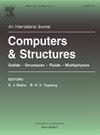利用晶格离散粒子模型建模和模拟混凝土力学行为的高效方法
IF 4.4
2区 工程技术
Q1 COMPUTER SCIENCE, INTERDISCIPLINARY APPLICATIONS
引用次数: 0
摘要
考虑到混凝土的异质性,在微观或中观尺度上模拟混凝土的准静态力学行为在计算成本方面很快变得不切实际。本手稿通过晶格离散粒子模型(LDPM)探讨了数值建模中的高效计算策略,LDPM 是模拟粗骨料级混凝土的最先进方法,强调了三种相互作用方法。LDPM 的原始配方采用 12 面配方,而本研究提出了一种基于 6 面或基于边缘的 LDPM 简化交互方法,旨在显著降低计算成本,同时保持对混凝土断裂行为的精确预测。该方法被系统地应用于各种标准混凝土试验,包括无约束压缩、双轴压缩、三轴压缩、扭转压缩、三点弯曲和循环压缩加载,以评估模型的预测能力。在拉伸和压缩加载条件下,对减少相互作用面数量的效率和准确性进行了认真讨论。结果表明,基于边缘和 6 面相互作用的方法大大降低了计算成本和内存使用量,同时提供了与 12 面模型相似的结果,但基于边缘相互作用的非约束压缩模拟除外。这项研究为推进 LDPM 在混凝土力学模拟中的应用开辟了一条前景广阔的道路。本文章由计算机程序翻译,如有差异,请以英文原文为准。
Efficient approaches for modeling and simulating the mechanical behavior of concrete using lattice discrete particle models
Simulating the quasi-static mechanical behavior of concrete at the micro- or meso-scale, considering its heterogeneous nature, quickly becomes impractical in terms of computational cost. This manuscript explores efficient computational strategies in numerical modeling by means of the Lattice Discrete Particle Model (LDPM), a state-of-the-art approach for simulating concrete at the coarse aggregate level, emphasizing three interaction approaches. Whereas the original formulation of LDPM employs a 12-facet formulation, this research proposes a simplified interaction approach for LDPM, based on either 6-facet or edge-based interactions, designed to significantly reduce computational costs while maintaining precise predictions of the concrete fracture behavior. This approach is systematically applied to a variety of standard concrete tests, including unconfined compression, biaxial compression, triaxial compression, torsional-compressive, three-point bending, and cyclic compression loading in order to assess the predictive capabilities of the model. The efficiency and accuracy of the reduced number of interaction surfaces are critically discussed in both tensile and compressive loading conditions. The results indicate that approaches based on edge-based and 6-facet interactions substantially reduce computational costs and memory usage while providing similar results to the 12-facet model, except for unconfined compression simulations based on edge-based interaction. This research opens a promising avenue for advancing the utilization of LDPM in concrete mechanics simulations.
求助全文
通过发布文献求助,成功后即可免费获取论文全文。
去求助
来源期刊

Computers & Structures
工程技术-工程:土木
CiteScore
8.80
自引率
6.40%
发文量
122
审稿时长
33 days
期刊介绍:
Computers & Structures publishes advances in the development and use of computational methods for the solution of problems in engineering and the sciences. The range of appropriate contributions is wide, and includes papers on establishing appropriate mathematical models and their numerical solution in all areas of mechanics. The journal also includes articles that present a substantial review of a field in the topics of the journal.
 求助内容:
求助内容: 应助结果提醒方式:
应助结果提醒方式:


